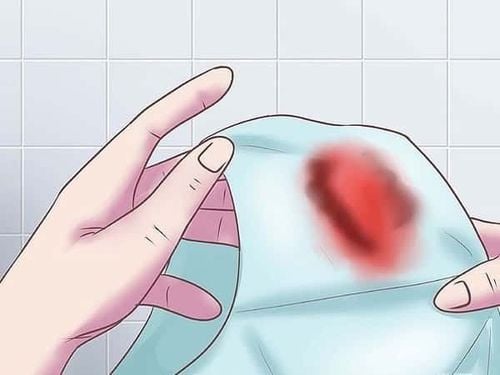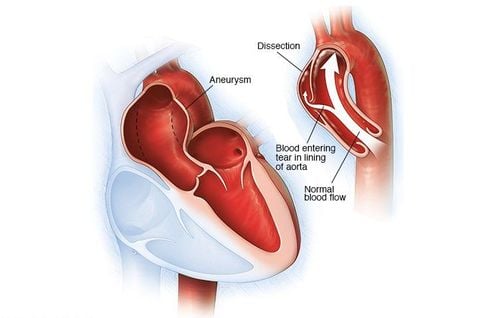This is an automatically translated article.
Ask
I am a doctor! My mother is 78 years old and has an abdominal aortic aneurysm. Doctor, can you treat an abdominal aortic aneurysm? I would like to thank you.
Anonymous question
Answer
Hello! Aortic aneurysm is a phenomenon in which the aorta increases in size with a diameter of more than 50% and deforms into a sac, rhombus shape, causing the vessel wall to stretch, which is easy to rupture. The disease is often associated with patients with a history of smoking, hypertension, diabetes. In most cases, patients only discover the disease after a physical examination, or after symptoms of abdominal pain, back pain.
How to treat an aortic aneurysm: Watchful waiting: If the abdominal aortic aneurysm is small, your doctor may recommend a “watchful wait.” This means that the patient will be monitored every 6-12 months for signs of changes in the size of the aneurysm. Your doctor may schedule regular CT scans or ultrasounds to monitor the aneurysm. This method is usually used for aneurysms that are less than 2 inches in diameter (about 5 to 5.5 centimeters). If you have high blood pressure, your doctor may prescribe blood pressure medication to relieve pressure in the weakened area of the aneurysm. If you are addicted to smoking, you need help to stop smoking.
The bulge does not go away on its own. It is extremely important that the patient continues to be closely monitored by the doctor, because the aneurysm can grow over time and reach a dangerous size. It can eventually rupture if not detected and treated.
Open surgery to repair aneurysms. The vascular surgeon may recommend a surgery called an open aneurysm repair if your aneurysm is causing symptoms or the aneurysm is larger than about 2 inches (about 5 inches). to 5.5 centimeters), or observed to be growing. In an open aneurysm repair, also called an aneurysm repair, the surgeon makes an incision in the patient's abdomen and replaces the aneurysm with a vascular graft. artificial. This graft is made of a durable artificial material, such as Dacron®, in the shape and size of a normal aorta. This durable graft replaces the aneurysm of the aorta and allows easy blood flow through the tube.
After surgery, the patient can stay in the hospital for 4 to 7 days. Depending on the patient's situation, it may take 6 weeks to 3 months to fully recover. More than 90% of open aortic repairs have good long-term outcomes.
Endothelial stenting instead of open repair of an aortic aneurysm, the vascular surgeon may consider a newer method called endovascular endovascular stenting. It's called "endovascular" because the treatment is done inside an artery using long, thin tubes called catheters that are threaded through the arteries. This method is less invasive because the surgeon will usually only need to make small incisions in the thigh area to insert the catheters. During surgery, the surgeon looks at live X-ray images, projected on a video screen, to insert a metal or cloth tube, called an endovascular coated stent (or endograft). to the site of the aortic aneurysm. Like the graft in open surgery, endovascular stenting also strengthens the aorta.
The recovery time for endovascular stents is usually shorter than for open surgery and your hospital stay can be reduced to 2 to 3 days. However, this method requires frequent post-operative monitoring with imaging studies such as CT scan after endovascular stenting to ensure that the stent continues to function properly. Endovascular coated stents may also require more revision procedures than open surgery. Furthermore, some aortic aneurysms may be unsuitable for this method because of the extent of the aneurysm spread, the involvement of the aneurysm with the renal artery, or other problems. While endovascular-coated stents may be a good choice for some patients with appropriate anatomical features of an aneurysm or in patients with medical conditions that increase surgical risk, in In other cases, open surgical repair of an aortic aneurysm is still the best way to treat an abdominal aortic aneurysm. The vascular surgeon will help the patient decide which treatment is best for each individual case.
Thus, aortic aneurysm is a treatable disease if detected early when there are no serious complications. Your mother has been diagnosed with an aortic aneurysm and needs to be re-examined by a Cardiologist so that the Doctor can make a timely decision on medical or surgical treatment.
You can take your mother to specialized medical facilities or hospitals of Vinmec Health System to be examined by a doctor and have in-depth advice. May your mother always be in good health.
Please dial HOTLINE for more information or register for an appointment HERE. Download MyVinmec app to make appointments faster and to manage your bookings easily.
Answered by Doctor General Internal Medicine Doctor - Department of Medical Examination & Internal Medicine - Vinmec Hai Phong International General Hospital













